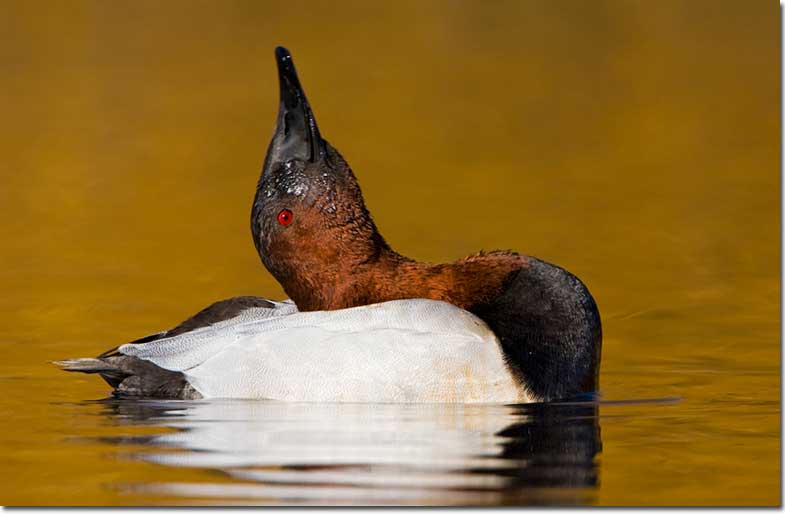Canvasbacks (Aythya valisineria) are iconic diving ducks with distinctive red eyes and wedge-shaped heads. They are the largest diving duck species in North America.
Males flaunt beautiful chestnut-red heads and white-and-black bodies, while females are more subdued brown and gray. You can find them in various aquatic and wetland habitats, but there are some fairly similar species to them.
Here is some more information about them so you can tell for sure.
On this page
Identification
Canvasbacks are relatively large ducks with a sleek and elongated body, measuring 19-22 inches long with a wingspan of 31-35 inches. They have a long, sloping profile with a distinctive wedge-shaped head and a thick neck.
Male
Male Canvasbacks in their breeding plumage have a whitish body, black chest and rear, rich and glossy chestnut-brown head and neck, and a black bill.
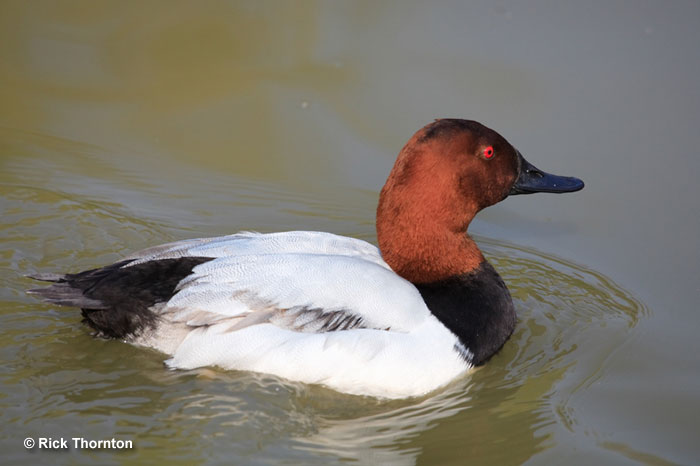
Their eyes are brilliant red, which can be a bit unnerving. In their nonbreeding plumage, males are duller overall and look more similar to females. Their bodies are a bit more grayish.
The chest and rear are still dark but not black as in their breeding plumage. That is also true for their head and neck, which are paler and duller brown.
Female
Female Canvasbacks have a similar plumage pattern, but their appearance is much duller and more subdued. Their bodies are light gray, their front and rear are dark brown, and their necks and heads are tan. They also have black bills, but their eyes are dark brown instead of red.
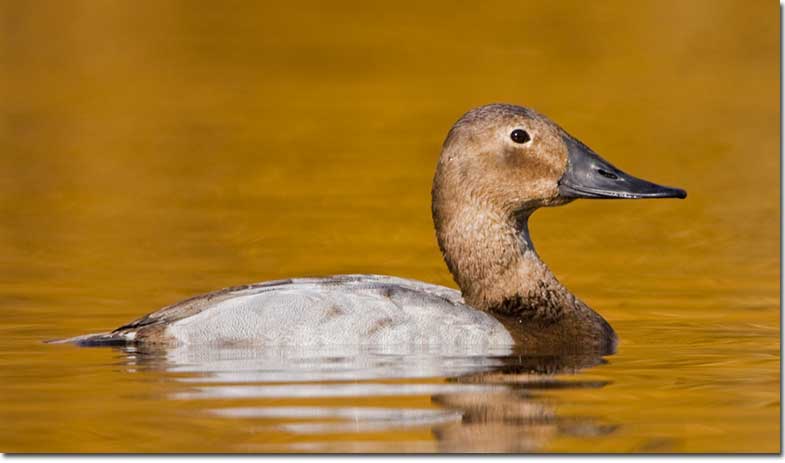
Juvenile Canvasbacks and Canvasbacks that are immature or in their non-breeding plumage generally look similar to females. They are brownish overall.
Vocalizations
Canvasbacks call only in specific situations. Otherwise, they are very silent birds. During courtship, males coo, and females emit rattling krrr-krrr sounds. When other birds approach their feeding area or the duck is alarmed, they may emit wheezing calls. Females occasionally quack, especially when they take flight.
Food
Canvasbacks’ diet varies with the season. They are overall omnivorous but mostly eat plants, especially during migration and the non-breeding season. During the breeding season, they also consume various aquatic invertebrates.
When it comes to the plant part of their diet, Canvasbacks consume a variety of aquatic vegetation, including seeds, roots, leaves, buds, and stems.
They are particularly fond of the tubers of various submerged plants, including sago pondweed, wild celery, grasses, and sedges.
In addition to plant material, Canvasbacks also feed on aquatic invertebrates. This includes insects, crustaceans, and mollusks such as snails, caddisfly larvae, dragonfly nymphs, and midge larvae.
They are most active in the morning and evening and often forage in shallow waters. Canvasbacks are skilled divers and mostly dive up to 7 feet to reach their food sources.
Their foraging strategy depends on what they’re feeding on and where. They may take insects and plant matter from the surface of the water or snatch insects out of the air.
If they are in very shallow water, they may use their feet to stir up sediment and then up-end to feed on it. In deeper bodies of water, they may also dive and excavate parts of plants that are underground or just eat their leaves and buds.
Nesting and Eggs
Canvasbacks are monogamous but switch mates every breeding season. Courtship displays of Canvasbacks often involve the male performing various ritualized behaviors to attract a mate.
They engage in head bobbing, chasing, and neck stretching to display their physical fitness and attractiveness. If the female accepts, she will stretch her neck and lower her head in turn.
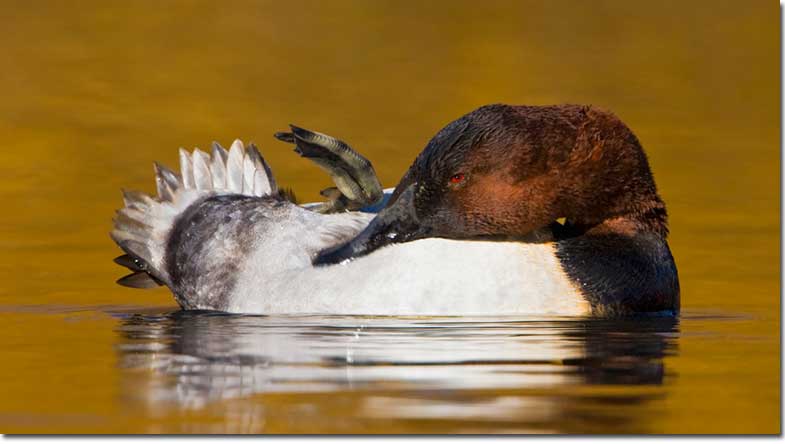
Male Canvasback displaying
Canvasbacks prefer to nest over shallow water among dense reeds, cattails, sedges, or rushes, but they may also nest on dry ground. The female builds the bulky platform from dead plants, lines the inside with down feathers, and tightly weaves it through emergent stalks of vegetation.
A female has only one brood in a year with 5-12 eggs in a clutch. Canvasback eggs are olive-gray, measure 2.4-2.6 inches long and 1.6-1.8 inches wide.
She incubates the eggs alone for 23-28 days and leads the chicks to water within several hours after hatching. Young have to forage for food by themselves, but the female watches over them for several weeks. The offspring become capable of flight about 60-70 days after hatching, but the mother bird abandons them slightly before.
Current Situation
Canvasbacks range throughout most of Mexico and North America. They breed throughout the prairie pothole region of central North America that covers parts of Alaska, Canada, and the northern United States. They migrate to the United States and Mexico for the winter and have a few year-round populations in the US as well.
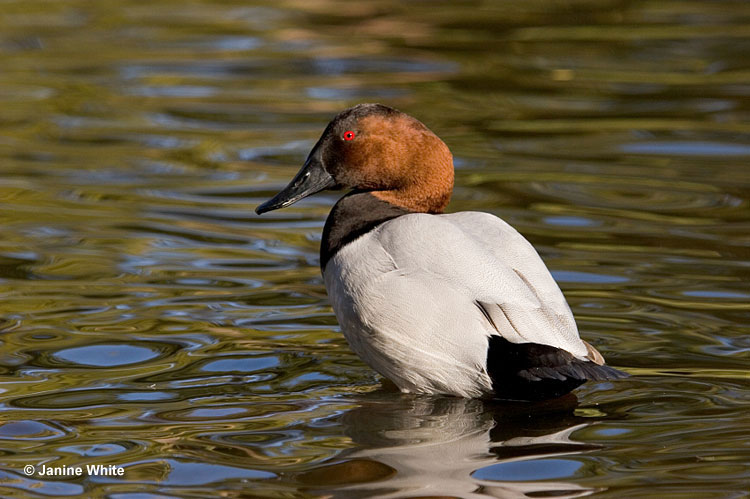
Canvasbacks inhabit various aquatic and wetland habitats. During the breeding season, they prefer small ponds, slow-moving rivers, small lakes, and marshes with dense vegetation.
On migration, you can find them on large lakes. Their wintering habitats mostly include protected bays, lagoons, and estuaries, but they are also found in interior lakes.
Canvasbacks are listed as of least concern on the IUCN Red List. Their numbers are constantly fluctuating, but according to the list, they are currently increasing.
However, this does not mean that they are safe. Canvasbacks are affected by various factors, such as habitat degradation, pollution, and most importantly hunting.
Facts
- Everyone has a favorite food, and so do Canvasbacks. For them, it is the wild celery, Vallisneria americana. Their love for this plant was so great that the second part of their scientific name, valisineria, is derived from wild celery’s scientific name!
- It can get quite confusing in the nests of Canvasbacks. Females lay their eggs in the nests of other female Canvasbacks, and oftentimes, Redheads and Ruddy Ducks also lay their eggs in Canvasback nests.
- Canvasbacks generally live for 10-19 years. The oldest Canvasback on record was at least 22 years and 7 months old!
- Canvasbacks are most comfortable in the water. This is their feeding ground, they sleep on the water, and they build their nests over water!
Similar Species
Canvasbacks are some unique-looking birds but still have a few similar species, especially if you look at them from afar. Here are some of the most similar ones and instructions on how to tell them apart.
Redhead
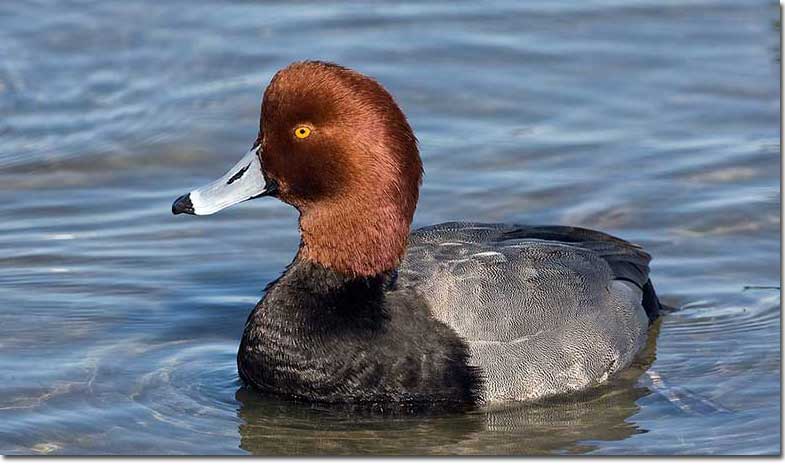
Redhead ducks range across most of North America and Mexico. Male Redheads have a gray body, black front and rear, rich cinnamon-red head, yellow eyes, and slaty blue bills with a black tip. Females are mottled brown all over with dark brown eyes and dark gray bills with a black tip.
Males of both species are very similar. However, male Redheads are smaller, have a gray instead of a white body, a slaty blue instead of a dark black bill, and yellow instead of red eyes. Their heads are more rounded, whereas the head of a Canvasback looks like a wedge. Females are similar as well but not very difficult to tell apart.
Greater Scaup
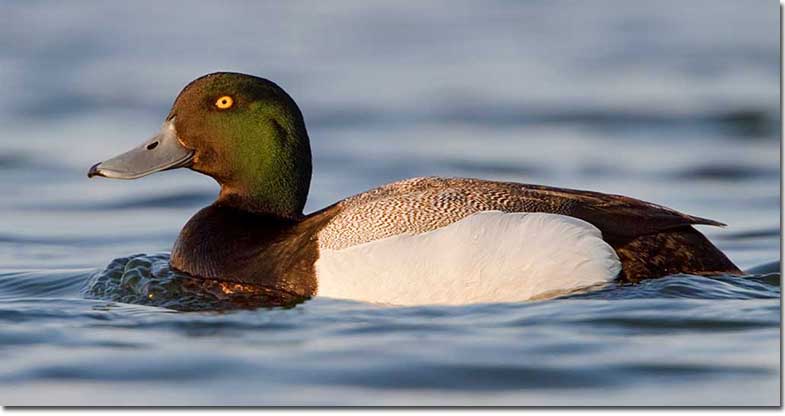
Greater Scaups range throughout most of North America. Male Greater Scaups have black heads with slight greenish iridescence, yellow eyes, and grayish bills. They have gray backs, white sides, and black chests and rears. Females are warm darkish brown all over with yellow eyes, grayish bills, and a white patch around their bills.
If you can make out the color of their heads, eyes, and/or bills, you will know which male you are dealing with. Male Greater Scaups have black instead of chestnut brown heads, yellow instead of red eyes, and bluish-grayish instead of black bills.
Females are different as well. Female Greater Scaups are brown all over and have a white patch around their gray bills and yellow eyes, whereas female Canvasbacks have a gray body, no white patch around their black bills, and brown eyes.
Ring-necked Duck
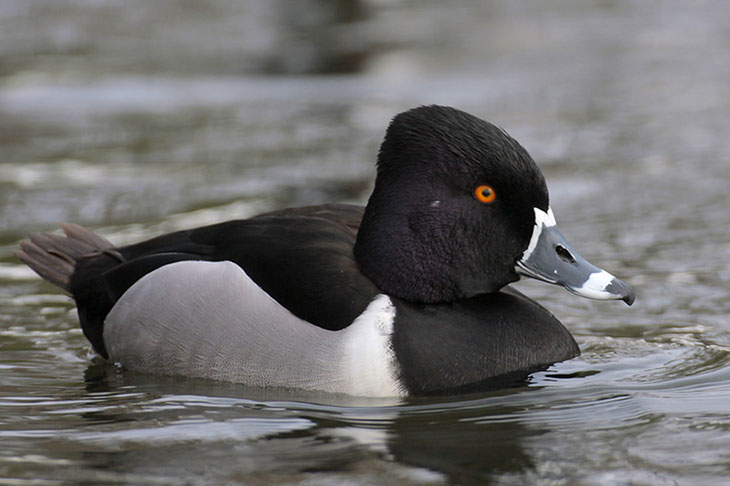
Ring-necked Ducks range throughout North America and Mexico. Male Ring-necked Ducks have overall black plumage with gray sides and white shoulders, yellow eyes, and gray bills with a black tip bordered by a white stripe.
Males may be a bit difficult to distinguish from afar if the lighting is bad, but if you see them nearby, then the differences should be noticeable. Canvasbacks have a chestnut brown head and neck instead of a black one and they don’t have a black back like the male Ring-necks do.
Female Ring-necked Ducks are brown all over and have a small white patch around their gray bills, whereas female Canvasbacks have gray bodies and no white patches or stripes around or on their black bills.
Frequently Asked Questions
How rare are Canvasbacks?
Canvasbacks are not rare, per se, as they are quite widespread and numerous, but it might still be uncommon to see one due to their habitat preferences.
What is the lifespan of a Canvasback?
Canvasbacks live for 10-19 years in the wild on average.
Are Canvasbacks diving ducks?
Canvasbacks are diving ducks.
Where are Canvasbacks most common?
Canvasbacks are most common in the prairie pothole region of North America.

